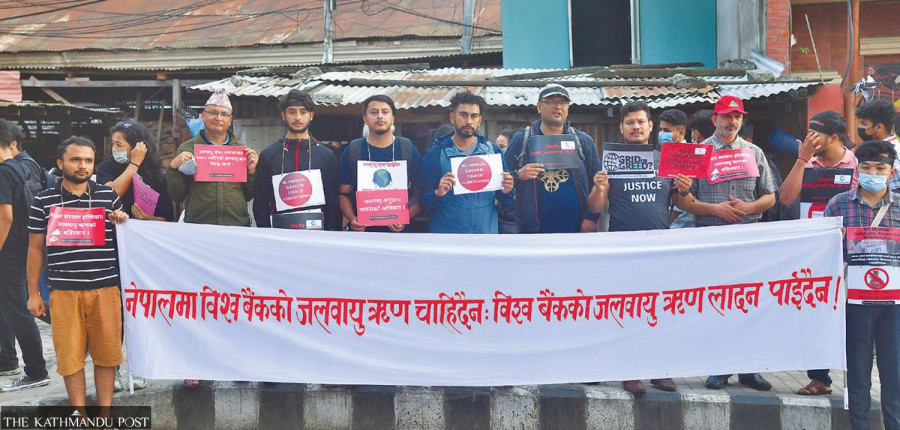Climate & Environment
Climate activists decry unwelcome moves in climate finance
There are concerns that the concessional loans could be categorised under climate finance.
Aakriti Ghimire
After the devastating 2015 earthquakes, many countries, donors and international financial institutions came to Nepal’s aid—in the form of donations, loans, grants and human resources.
One prominent example is that of the World Bank which launched the Earthquake Housing Reconstruction Project.
However, according to the World Bank, the housing reconstruction project did not just respond to a humanitarian crisis but also to climate change adaptation.
A whopping 86 percent of the project’s total committed budget was reported as finance for climate change adaptation. Researchers at CARE Denmark & CARE Netherlands found that the project over-reported $328 million as funding for adaptation and climate-resilient development in Nepal.
Climate activists and experts are wary that the same tale might repeat itself with a recent development.
On Monday, Nepal government signed an agreement with the World Bank for a USD 100 million (approximately 12.75 billion Nepali rupees) financing to help improve the enabling environment for Nepal’s green, resilient, and inclusive development (GRID) pathway.
This financing is from the World Bank Group’s International Development Association, or the IDA, of which Nepal has been a member since 1962.
The IDA financing helps the world’s poorest countries, including Nepal, with their bid to reduce poverty by providing grants and zero to low-interest loans to boost economic growth, lessen inequality, and improve living conditions, officials at the World Bank said.
Given that the IDA has implemented 107 projects in Nepal since 1988, it is a regular aid received by Nepal.
“Nepal’s first GRID development policy credit is just one contribution to help realise Nepal’s shift to greener, more resilient, and inclusive development path,” said Lada Strelkova, World Bank Acting Country Director for Maldives, Nepal, and Sri Lanka, in an email response to the Post. “Climate action is an important part of this path as climate and development are closely intertwined.”
Climate activists, however, are infuriated at Nepal’s acceptance of the loan. Their biggest worry is that this regular aid could once again be simultaneously counted towards meeting both climate change obligations and development commitments, also known as double counting.
“And now while the donor is explicitly saying GRID loan is also for #climate resilience—and that having sparked criticism that Nepal shouldn't be burdened with loan and that it should be given grant—Finance Ministry officials are quoted saying ‘it is regular development aid,’” tweeted Navin Singh Khadka, an environment reporter with the BBC.
According to the Ministry of Finance, the loan will not be implemented in programmes related to forestry, environment and climate change because Nepal isn’t responsible for global climate change.

Funds from the loan will only be used to implement the GRID approach, through a policy and institutional development approach, officials at the Ministry of Finance said.
“This is not under climate finance. This is a budgetary support received by the government based on our climate-related policy work. Not a single penny of this will be spent on climate adaptation,” said Ishwari Prasad Aryal, joint secretary at the International Economic Cooperation Coordination Division (IECCD) of the Ministry of Finance.
To receive this loan, Nepal developed and approved a new policy and institutional actions that address: air pollution and drinking water quality, land use planning, community-based sustainable forest management and associated women’s empowerment, resilient livestock and agriculture, enhancements to Nepal’s hydrological and meteorological network, and solid waste management.
Aryal said that “Nepal government has the full discretion in deciding where to invest the budget and in the upcoming fiscal year, it will be implemented in developing infrastructures, particularly roads and bridges.”
The loan is provided at zero interest rate, but an annual service charge of 0.75 percent per annum is applied. This credit has a maturity of 38 years, including a grace period of 6 years and repayment begins in 2028 and continues to 2060.
“This is not a commercial loan but a development policy credit, meaning that we can access the funds only because we implement necessary policy level changes in various ministries,” said Yug Raj Pandey, under secretary in the International Economic Cooperation Coordination Division at the Ministry of Finance.
Given the World Bank’s previous overreporting of its climate financing, the ministry’s clarification doesn’t appease climate activists and experts.
The activists organised a protest in Maitighar, Kathmandu on Wednesday against the pledged climate loans with the slogan #NoClimateLoans.
Some donors count most development aid or official development assistance, even when not primarily for “climate action” under climate finance. This allows the donors to get away with contributing less than their share of financial obligations. Climate finance experts say not only is it unfair towards vulnerable countries but also jeopardises both climate change and development commitments.
Research finds that rich nations and institutions have been routinely over-reporting climate adaptation finance by USD 20 billion, leaving the world’s most vulnerable countries like Nepal with only receiving a fraction of the support promised.
The same report also finds that the World Bank has over-reported $832 million in total.
Another research finds that the status of transparency and accountability in climate finance is unsatisfactory in both donors and recipients, to the extent it has “many a time resulted in double/triple/quadruple counting of the funds in the books.”
Bilateral and multilateral development financial institutions are responsible for providing climate financing for least developed countries like Nepal. However, a concessional loan as provided by the World Bank will likely be labelled under climate finance, according to experts.
“In the name of GRID, this money will most likely be labelled as climate finance. The World Bank should clarify whether it will be labelled climate finance or not,” says Raju Pandit Chhetri, a climate finance expert.
“If they label it so, and ask Nepal to pay back on climate finance, then they will be penalising us doubly—for bearing the brunt of climate change and for having to pay back the debt they forced us to take.”




 6.12°C Kathmandu
6.12°C Kathmandu








%20(1).jpg&w=300&height=200)

